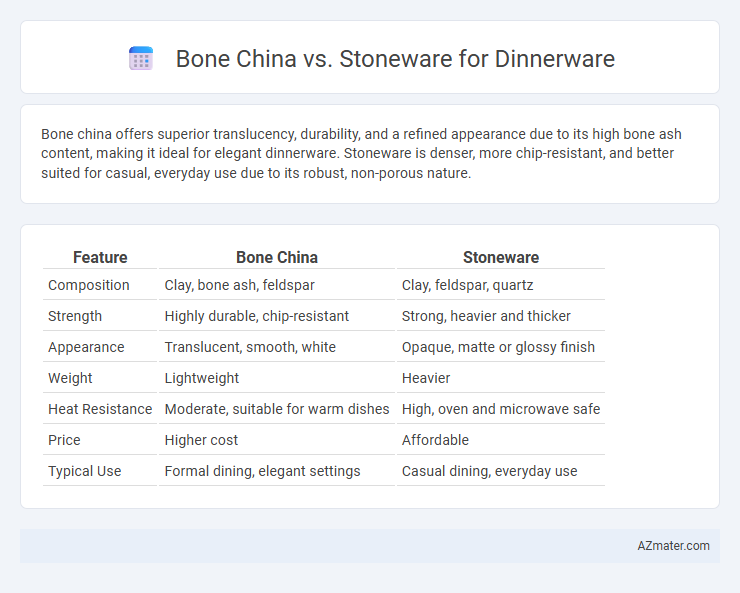Bone china offers superior translucency, durability, and a refined appearance due to its high bone ash content, making it ideal for elegant dinnerware. Stoneware is denser, more chip-resistant, and better suited for casual, everyday use due to its robust, non-porous nature.
Table of Comparison
| Feature | Bone China | Stoneware |
|---|---|---|
| Composition | Clay, bone ash, feldspar | Clay, feldspar, quartz |
| Strength | Highly durable, chip-resistant | Strong, heavier and thicker |
| Appearance | Translucent, smooth, white | Opaque, matte or glossy finish |
| Weight | Lightweight | Heavier |
| Heat Resistance | Moderate, suitable for warm dishes | High, oven and microwave safe |
| Price | Higher cost | Affordable |
| Typical Use | Formal dining, elegant settings | Casual dining, everyday use |
Introduction to Bone China and Stoneware
Bone china, renowned for its high levels of whiteness, translucency, and durability, contains bone ash, which enhances its strength and chip resistance while maintaining a lightweight feel. Stoneware is a dense, non-porous ceramic made from stoneware clay fired at high temperatures, known for its sturdiness, resistance to chipping, and rustic, earthy aesthetic. Both materials are widely used for dinnerware, with bone china favored for its elegance and refinement, whereas stoneware offers practicality and a more casual, robust appeal.
Material Composition: Bone China vs Stoneware
Bone china is composed primarily of bone ash, feldspar, and kaolin, resulting in a lightweight, translucent, and highly durable ceramic. Stoneware consists mainly of clay fired at high temperatures, producing a dense, opaque, and chip-resistant material. The bone ash in bone china enhances its strength and whiteness, while stoneware's heavy clay composition offers robustness and rustic appeal.
Aesthetic Appeal and Design Variety
Bone china offers a translucent, delicate appearance with intricate patterns and a glossy finish that enhances its luxurious aesthetic appeal. Stoneware features a more rustic, earthy look with matte or satin glazes, providing a broader range of textures and artisanal designs. Both materials deliver distinct design varieties, with bone china favoring elegance and stoneware embracing a handcrafted, robust charm.
Strength and Durability Comparison
Bone china is renowned for its exceptional strength and chip resistance due to its high bone ash content, making it more durable than traditional porcelain. Stoneware, made from dense clay fired at high temperatures, offers robust resistance to chipping and cracking but tends to be heavier and less translucent than bone china. While both materials provide durability suitable for everyday use, bone china combines lightweight elegance with superior strength, whereas stoneware delivers a sturdy, rustic finish capable of withstanding heavy use.
Weight and Handling: Bone China vs Stoneware
Bone china is significantly lighter and more delicate than stoneware, offering a refined feel that enhances ease of handling during meals. Stoneware is heavier and more robust, providing durability but requiring a sturdier grip to prevent accidental drops. The lightweight nature of bone china makes it ideal for everyday use and elegant dining, while stoneware suits casual settings and heavy-duty use.
Heat Resistance and Microwave Safety
Bone china offers moderate heat resistance and is generally safe for microwave use due to its fine, vitrified composition that prevents cracking under typical heating conditions. Stoneware excels in heat retention and can withstand higher temperatures, making it ideal for oven-to-table serving but may vary in microwave safety based on glaze and manufacturing quality. Both materials require checking manufacturer guidelines to ensure microwave compatibility and avoid thermal shock.
Maintenance and Cleaning Requirements
Bone china requires gentle cleaning with mild detergents and soft cloths to prevent chipping and maintain its translucent finish, while it is generally dishwasher-safe but better cared for by handwashing. Stoneware boasts higher durability and resistance to chips and scratches, making it suitable for dishwashers and even microwave use, with easy-to-clean glazed surfaces that handle heavy-duty use well. Proper maintenance of bone china involves careful handling and avoiding abrasive materials, whereas stoneware offers more robust, low-maintenance cleaning options for everyday dining.
Price Range and Value for Money
Bone china offers a higher price range, typically ranging from $50 to $200 per set, due to its refined translucency, lightweight feel, and durability. Stoneware, priced more affordably between $30 and $100 per set, provides excellent sturdiness and chip resistance, making it ideal for everyday use. While bone china delivers a luxurious appearance and long-term elegance, stoneware offers superior value for money through its robustness and budget-friendly options.
Environmental Impact and Sustainability
Bone china, composed primarily of bone ash, offers high durability and whiteness but often involves animal-derived materials, raising ethical and sustainability concerns compared to stoneware, which is made from natural clays and fired at high temperatures without animal by-products. Stoneware's production typically has a lower environmental footprint due to abundant raw material sources and less energy-intensive processes, contributing to better biodegradability and recyclability. Choosing stoneware dinnerware supports eco-friendly practices through sustainable sourcing and end-of-life environmental benefits, making it a preferable option for reducing ecological impact.
Choosing the Right Dinnerware for Your Needs
Bone china offers a lightweight, translucent appearance with high durability and chip resistance, making it ideal for formal dining and elegant settings. Stoneware provides a thicker, more rustic finish with excellent microwave and oven safety, suitable for everyday use and casual gatherings. Selecting between bone china and stoneware depends on your priorities for aesthetics, durability, and functional versatility in daily dining.

Infographic: Bone china vs Stoneware for Dinnerware
 azmater.com
azmater.com